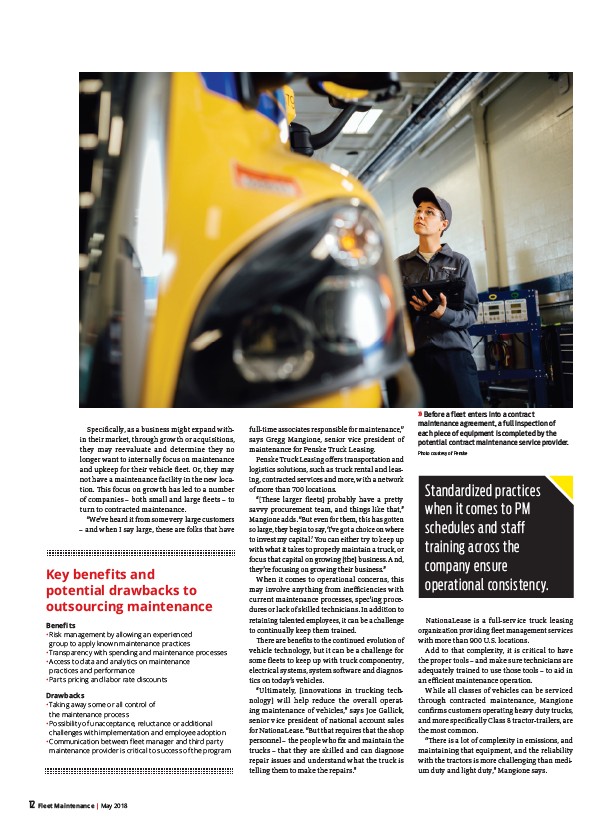
Specifi cally, as a business might expand within
their market, through growth or acquisitions,
they may reevaluate and determine they no
longer want to internally focus on maintenance
and upkeep for their vehicle fl eet. Or, they may
not have a maintenance facility in the new location.
Th is focus on growth has led to a number
of companies – both small and large fl eets – to
turn to contracted maintenance.
“We’ve heard it from some very large customers
– and when I say large, these are folks that have
12 Fleet Maintenance | May 2018
full-time associates responsible for maintenance,”
says Gregg Mangione, senior vice president of
maintenance for Penske Truck Leasing.
Penske Truck Leasing off ers transportation and
logistics solutions, such as truck rental and leasing,
contracted services and more, with a network
of more than 700 locations.
“Th ese larger fl eets probably have a pretty
savvy procurement team, and things like that,”
Mangione adds. “But even for them, this has gotten
so large, they begin to say, ‘I’ve got a choice on where
to invest my capital.’ You can either try to keep up
with what it takes to properly maintain a truck, or
focus that capital on growing the business. And,
they’re focusing on growing their business.”
When it comes to operational concerns, this
may involve anything from ineffi ciencies with
current maintenance processes, spec’ing procedures
or lack of skilled technicians. In addition to
retaining talented employees, it can be a challenge
to continually keep them trained.
Th ere are benefi ts to the continued evolution of
vehicle technology, but it can be a challenge for
some fl eets to keep up with truck componentry,
electrical systems, system soft ware and diagnostics
on today’s vehicles.
“Ultimately, innovations in trucking technology
will help reduce the overall operating
maintenance of vehicles,” says Joe Gallick,
senior vice president of national account sales
for NationaLease. “But that requires that the shop
personnel – the people who fi x and maintain the
trucks – that they are skilled and can diagnose
repair issues and understand what the truck is
telling them to make the repairs.”
» Before a fleet enters into a contract
maintenance agreement, a full inspection of
each piece of equipment is completed by the
potential contract maintenance service provider.
Photo courtesy of Penske
NationaLease is a full-service truck leasing
organization providing fl eet management services
with more than 900 U.S. locations.
Add to that complexity, it is critical to have
the proper tools – and make sure technicians are
adequately trained to use those tools – to aid in
an effi cient maintenance operation.
While all classes of vehicles can be serviced
through contracted maintenance, Mangione
confi rms customers operating heavy duty trucks,
and more specifi cally Class 8 tractor-trailers, are
the most common.
“Th ere is a lot of complexity in emissions, and
maintaining that equipment, and the reliability
with the tractors is more challenging than medium
duty and light duty,” Mangione says.
Key benefits and
potential drawbacks to
outsourcing maintenance
Benefits
• Risk management by allowing an experienced
group to apply known maintenance practices
• Transparency with spending and maintenance processes
• Access to data and analytics on maintenance
practices and performance
• Parts pricing and labor rate discounts
Drawbacks
• Taking away some or all control of
the maintenance process
• Possibility of unacceptance, reluctance or additional
challenges with implementation and employee adoption
• Communication between fleet manager and third party
maintenance provider is critical to success of the program
Standardized practices
when it comes to PM
schedules and staff
training across the
company ensure
operational consistency.